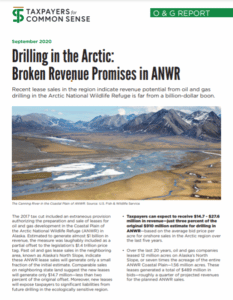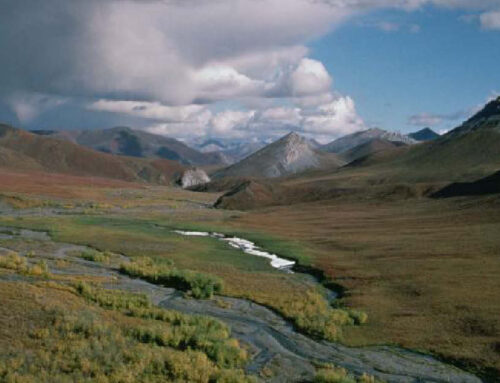The budget reconciliation process outlined by S. Con. Res. 14 – the FY2022 budget resolution – enables Congress to spend significant sums and implement sweeping reforms. To protect taxpayers, Congress must ensure the reconciliation package furthers legitimate public needs, includes only fiscally sustainable policies, and avoids creating liabilities for taxpayers down the line. Allocating federal dollars alone, however, would limit what the reconciliation package can accomplish. Congress must capitalize on this opportunity to implement overdue reforms that will align revenue with spending, improve the grave budget outlook, and foster resilience instead of dependence on federal subsidies.
Below are brief descriptions of overdue fiscal reforms to resource and minerals management on federal lands that Congress should enact to raise revenue and protect taxpayers in the long term.
Reform the Federal Oil and Gas Leasing System
Royalty Rates
The federal onshore oil and gas royalty rate is set at 12.5 percent, well below the offshore rate of 18.75%, and the rates charged on state lands. If we had been collecting the offshore rate on every barrel of oil and cubic foot of gas produced from federal lands over the last decade, taxpayers could’ve gotten up to $12.35 billion more.
Check out our report here.
Rental Rates
The current rental rates are set at $1.50/acre for the first half of the lease term and $2.00/acre for the second half of the lease term. The rates were set in 1987 and have not been adjusted for inflation since then. Had the rates kept up with inflation, taxpayers would have received roughly $330 million more in rental revenues from FY2011 to FY2020.
To learn more about rental revenue loss, read our analysis here.
Minimum Bids in Lease Sales
Like rent, the minimum amount companies can bid at auctions for federal oil and gas leases hasn’t been updated since 1987. It remains at $2/acre, and bidders take full advantage. Of the 544,000 acres sold at auction in 2020, roughly 200,000 got the minimum bid. From FY2011 to FY2020, taxpayers would have received $5 million more had minimum bids been adjusted for inflation.
Noncompetitive Leasing
In 1987, Congress created the competitive leasing system to get more revenue from leasing valuable federal land. However, the process has a significant loophole: the day after a competitive auction, a company (or land speculator) can avoid paying a bid altogether by submitting a noncompetitive offer for anything that didn’t sell the day before.
Oil and gas companies have disproportionately used the noncompetitive system to avoid paying the $2/acre minimum bid on parcels with more acreage. Over the last 10 years, 2.3 million acres – an area roughly twice the size of Rhode Island – have been leased with no bid. From 2001 to 2020, close to six million acres in Nevada were leased through the noncompetitive process, which accounts for 53% of all federal land leased noncompetitively nationwide. BLM records indicate that out of 2,500 noncompetitive leases issued since 1999 in Nevada, only two entered production. Millions of acres of federal land are currently locked up in nonproducing oil and gas leases that are unlikely to ever enter production and are unavailable for other, more optimal uses like recreation, wildlife and fish, grazing, timber, etc.
To learn more about noncompetitive leasing, read our policy brief here.
Limit Liabilities and Fiscally Reckless Leasing
The Department of the Interior has wide discretion to choose where leasing should be prioritized over other land uses, and conversely, where leasing is not in the public interest. Strategic leasing better focuses the Department’s limited resources. Regions where lease sales consistently fail to recoup administration costs should be abandoned. As should areas where potential revenues are dwarfed by liabilities associated with drilling. Given the predictably dismal returns from the first lease sale in the Arctic National Wildlife Refuge due to minimal industry interest, it is clear that taxpayer interest is better served by limiting development in the region and the liabilities that accompany it.
Read our report on why leasing in the Arctic National Wildlife Refuge is a bad idea for taxpayers here.
Reclamation Bonding
If not reclaimed timely and properly, orphaned oil and gas wells can pose environmental and public health risks. Making sure that oil and gas companies post bonds sufficiently large to pay for reclamation in case they go bankrupt is the best way to hold the industry accountable and protect taxpayers from paying for industry messes. The Government Accountability Office found that 84 percent of bonds covering 99.5 percent of all wells are not enough to cover even the low-end estimate of reclamation costs. The bonding minimums have not been adjusted for inflation since the 1950s and 1960s. Adjusted for inflation, today’s $10,000 minimum bond for an individual lease was the equivalent of $87,436 in coverage when the minimum was set in 1960. The rate of $25,000 for statewide bonds originally provided the equivalent of $240,531 in coverage in 1954, and the $150,000 nationwide bond minimum provided $1,443,184 in coverage. Low bond minimums incentivize operators not to reclaim wells when it is more costly to clean up well sites than simply forfeit the minimum bonded amount. Insufficient bonds will inevitably make taxpayers pick up the tab that should have been paid for by the industry.
Read more about oil and gas bonding here.
Reform Hardrock Mining Management
The mining of hardrock minerals like gold, silver, uranium, zinc, copper, et al on federal land is still governed by the General Mining Law of 1872. The antiquated law allows mining companies to extract precious metals from public lands without paying taxpayers a dime in royalties, or even reporting how much was taken. The law also enabled mining companies to abandon mines when operations ended, leading to hundreds of thousands of abandoned mine sites that will cost taxpayers billions of dollars to clean up. Updating the management of hardrock mining to a leasing system – like Congress did for oil and gas production on federal lands a century ago – is necessary to get taxpayers a fair return from development of public mineral resources. TCS estimates the Department of the Interior could have collected $1.9 billion from 2010 to 2019 with a royalty of five percent just from federal gold production in Nevada. Implementing a royalty for all hardrock production would bring in substantially more revenue.
Read more about hardrock mining on federal lands here.
Avoid Past Mistakes with Clean Energy Incentives
Any new policies or programs should be fiscally responsible and avoid the creation of long-term liabilities for the climate and taxpayers. A potential new Clean Electricity Payment Program or other clean energy subsidies should be mindful of past mistakes made with bioenergy, nuclear, and other subsidies that have done more harm than good while wasting billions of taxpayer dollars. Subsidizing biomass, for instance, may not result in greenhouse gas emission reductions as intended. Creating new subsidies for these types of energy will not bring the U.S. closer to meeting climate goals and will instead only create more long-term liabilities. The Committee should avoid these pitfalls and instead invest in real, lasting climate solutions.













Get Social